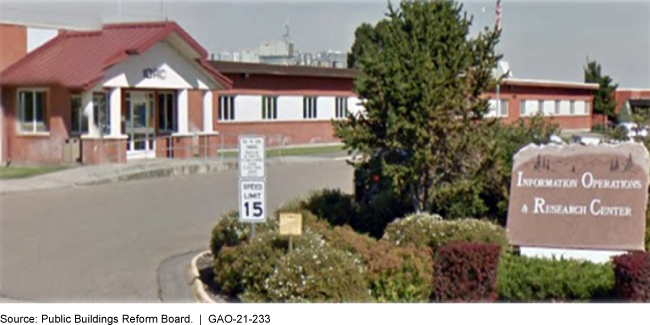Federal Real Property: Additional Documentation of Decision Making Could Improve Transparency of New Disposal Process
Fast Facts
The Public Buildings Reform Board was created in 2016 to help dispose of unneeded federal real property (primarily land and buildings). The Board identified 44 properties and recommended 12 for disposal in 2019. The Office of Management and Budget approved these properties for disposal in January 2020. However, we found that the Board did not fully document the process it used to evaluate these properties.
We recommended that the Board fully document its decision-making process to help stakeholders, including Congress, understand the rationales for and financial implications of disposing of federal real property.
An example of property in Idaho Falls, Idaho recommended for disposal by the Board

Highlights
What GAO Found
In 2016, the Federal Assets Sale and Transfer Act (FASTA) created the independent Public Buildings Reform Board (the Board) to support a new, three-round process for disposing of unneeded federal real property. The first of these rounds required the Board to identify and recommend at least five high-value disposal candidates with a total market value between $500 and $750 million. To identify these properties, the General Services Administration (GSA) collected and evaluated agency recommendations; a GSA-hired contractor analyzed real property data; and the Board held public hearings, visited properties, and met with federal officials. This process resulted in identifying 44 properties. The Board then took various steps to evaluate the 44 properties and recommended 12 final disposal candidates that the Office of Management and Budget (OMB) approved in January 2020. (See figure.) However, the Board did not fully document the process used to evaluate these candidates. For example, the Board's rationales for why individual candidates were or were not recommended were vague or incomplete. Full documentation on the decision-making process would better position stakeholders, including members of Congress, to understand the Board's rationales, especially for decisions with financial implications.
Process Used by Stakeholders for Identifying and Recommending High-Value Federal Real Property for Potential Disposal Candidates

According to Board and selected federal agency officials, FASTA made it easier for agencies to pursue high-value property disposals due, in part, to exemptions from some requirements, such as having to first offer properties to federal, state, or local agencies. However, FASTA's effect on other long-standing challenges, including funding to prepare properties for disposal, is unclear. For example, FASTA created a dedicated funding source to implement Board recommendations including those related to covering disposal costs, such as relocating agency staff. However, officials expressed concern that access to these funds is not automatic and must go through the annual appropriations process, which rarely coincides with the timing of these projects. The administration proposed legislative language to make proceeds from the sale of assets in fiscal year 2021 available without additional actions by Congress. However, as of January 2021, legislation containing the proposed language had not been enacted. This report discusses elements Congress may wish to evaluate when determining whether to grant such budget-related flexibility.
Why GAO Did This Study
GAO designated federal real property management, including the disposal of properties, as a high-risk area in 2003. FASTA included a provision for GAO to review the recommendations and selection processes such as those used in the first round of identifying and recommending high-value properties as candidates for disposal.
This report examines: (1) how stakeholders implemented FASTA to identify and evaluate high-value properties as potential disposal candidates and (2) stakeholder views on the extent to which FASTA helped agencies with the disposal of unneeded high-value properties and addressed long-standing challenges in disposing of federal properties. GAO reviewed FASTA and analyzed documents from the Board, OMB, GSA, and selected 14 federal agencies to examine the processes they used and the challenges they encountered under the FASTA process. Agencies were selected based on their recommendations of high-value properties and inclusion on the Board's final list, among other things. GAO also interviewed officials from the Board, OMB, GSA, and selected federal agencies.
Recommendations
GAO is recommending that the Board fully document its process for recommending FASTA disposal candidates, including the rationales behind disposal decisions. The Board noted plans to develop more documentation of its future disposal decisions.
Recommendations for Executive Action
| Agency Affected | Recommendation | Status |
|---|---|---|
| Public Buildings Reform Board | The Public Buildings Reform Board should fully document its process for future rounds of FASTA recommendations, including rationales for recommending or not recommending individual disposal candidates. (Recommendation 1) |
Previously, the Public Buildings Reform Board included rationales for recommending disposal candidates for the second FASTA round as part of its report submitted to the Office of Management and Budget. However, the Board did not document the reasons why some properties that were considered were ultimately not recommended. In August 2024, Board officials updated GAO on the process being used to develop recommendations for the third FASTA round - the Board plans to announce those recommendations at the end of this calendar year. GAO will continue to follow-up with the Board to monitor and report on progress to address GAO's recommendation, including developing and documenting rationales for not recommending individual disposal candidates.
|
